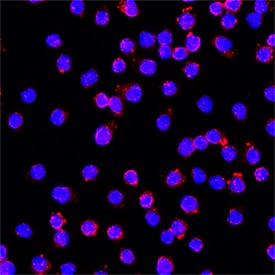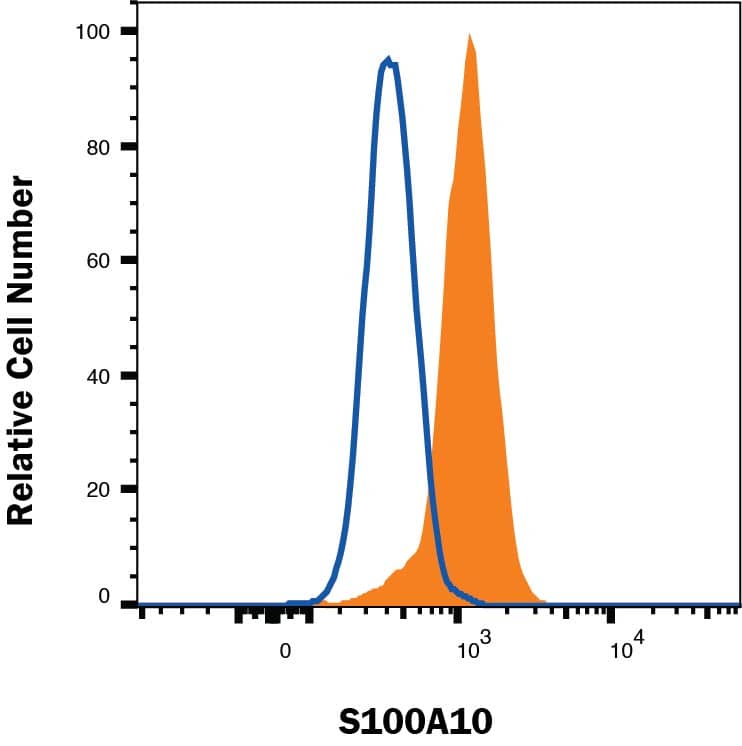Mouse S100A10 Antibody Summary
Met1-Lys97
Accession # P08207
Applications
Please Note: Optimal dilutions should be determined by each laboratory for each application. General Protocols are available in the Technical Information section on our website.
Scientific Data
 View Larger
View Larger
Detection of Mouse S100A10 by Western Blot. Western blot shows lysates of mouse lung tissue and MEF mouse embryonic feeder cells. PVDF membrane was probed with 1 µg/mL of Rat Anti-Mouse S100A10 Monoclonal Antibody (Catalog # MAB2377) followed by HRP-conjugated Anti-Rat IgG Secondary Antibody (Catalog # HAF005). A specific band was detected for S100A10 at approximately 11 kDa (as indicated). This experiment was conducted under reducing conditions and using Immunoblot Buffer Group 1.
 View Larger
View Larger
S100A10 in TK‑1 Mouse T Cell Line. S100A10 was detected in immersion fixed TK‑1 mouse T cell lymphoma cell line using Rat Anti-Mouse S100A10 Monoclonal Antibody (Catalog # MAB2377) at 5 µg/mL for 3 hours at room temperature. Cells were stained using the NorthernLights™ 557-conjugated Anti-Rat IgG Secondary Antibody (red; NL013) and counterstained with DAPI (blue). Specific staining was localized to cytoplasm. Staining was performed using our protocol for Fluorescent ICC Staining of Non-adherent Cells.
 View Larger
View Larger
Detection of S100A10 in Raw264 Mouse Cell Line by Flow Cytometry. Raw264 mouse monocyte/macrophage cell line was stained with Rat Anti-Mouse S100A10 Monoclonal Antibody (Catalog # MAB2377, filled histogram) or Rat IgG2A Isotype Control (MAB006, open histogram) followed by PE-conjugated Anti-Rat IgG Secondary Antibody (F0105B). To facilitate intracellular staining, cells were fixed and permeabilized with FlowX FoxP3 Fixation & Permeabilization Buffer Kit (FC012). Staining was performed using our Staining Intracellular Proteins protocol.
Preparation and Storage
- 12 months from date of receipt, -20 to -70 °C as supplied.
- 1 month, 2 to 8 °C under sterile conditions after reconstitution.
- 6 months, -20 to -70 °C under sterile conditions after reconstitution.
Background: S100A10
S100A10, also called p11, is a 97 amino acid member of the S100 family of EF hand proteins, but does not bind calcium. It is primarily found, either within or on the surface of mast cells, as a complex of two annexin A2 subunits with two S100A10 subunits. Extracellular S100A10 is a plasminogen receptor important for plasmin production and cellular invasiveness. Intracellular S100A10 may target ligands to the endoplasmic reticulum. Mouse S100A10 shows 92% amino acid identity with human S100A10.
Product Datasheets
Citations for Mouse S100A10 Antibody
R&D Systems personnel manually curate a database that contains references using R&D Systems products. The data collected includes not only links to publications in PubMed, but also provides information about sample types, species, and experimental conditions.
2
Citations: Showing 1 - 2
Filter your results:
Filter by:
-
PSA-NCAM colocalized with cholecystokinin-expressing cells in the hippocampus is involved in mediating antidepressant efficacy
Authors: J Yamada, C Sato, K Konno, M Watanabe, S Jinno
J. Neurosci., 2019-12-04;0(0):.
Species: Mouse
Sample Types: Whole Tissue
Applications: IHC -
Annexin2 coating the surface of enlargeosomes is needed for their regulated exocytosis.
Authors: Lorusso A, Covino C, Priori G, Bachi A, Meldolesi J, Chieregatti E
EMBO J., 2006-11-02;25(23):5443-56.
Species: Rat
Sample Types: Whole Cells
Applications: ICC
FAQs
No product specific FAQs exist for this product, however you may
View all Antibody FAQsReviews for Mouse S100A10 Antibody
There are currently no reviews for this product. Be the first to review Mouse S100A10 Antibody and earn rewards!
Have you used Mouse S100A10 Antibody?
Submit a review and receive an Amazon gift card.
$25/€18/£15/$25CAN/¥75 Yuan/¥2500 Yen for a review with an image
$10/€7/£6/$10 CAD/¥70 Yuan/¥1110 Yen for a review without an image

